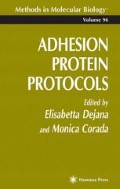Abstract
The adhesion of cells is normally studied in the absence of flow. In a classic setup, ELISA wells are coated with an adhesive protein and subsequently incubated with a cell suspension. The gravity is responsible for the transport of the cells to the adhesive surface. This setup is not appropriate for blood cells, such as platelets, because platelet adhesion occurs physiologically under flow conditions. The shear stress induced by the flow causes qualitative and quantitative differences in adhesion (1). Blood platelets have a relatively low density and do not settle easily under gravity. Under flow conditions, convective diffusion of platelets to the vessel wall is responsible for a strong increase of platelet number near the reactive surface, resulting in a strongly enhanced platelet adhesion. A second important effect of flow is mediated by the shear stresses exerted on the platelets. To overcome these stresses, a special protein, the von Willebrand factor, is necessary, which has a very high affinity for the platelet membrane receptor glycoprotein Ib. In the absence of flow, the presence of von Willebrand factor is not necessary for platelet adhesion, but with increasing shear rates, the presence of von Willebrand factor becomes essential. Another disadvantage of studying platelet adhesion under static conditions is that owing to the presence of red blood cells, these experiments must be performed with washed platelets, and the required centrifugation steps cause unwanted platelet activation.
Access this chapter
Tax calculation will be finalised at checkout
Purchases are for personal use only
References
Baumgartner, H. R. and Haudenschild, C. (1972) Adhesion of platelets to subendothelium. Ann. NY Acad. Sci. 201, 22–36.
Sakariassen, K. S., Aarts, P. A. M. M., de Groot, Ph. G., Houdijk, W. P. M., and Sixma, J. J. (1983) A perfusion chamber developedto investigate platelet interaction in flowing blood with human vessel wall cells, their extracellular matrix and purified proteins. J. Lab. Clin. Med. 102, 522–535.
Gabrowski, E. F., Herther, K. K., and Didisheim, P. (1976) Human vs dog platelet adhesion to cuprophane under controlled conditions of wholke blood flow. J. Lab. Clin. Med. 88, 368–374.
Muggli, R., Baumgartner, H. R., Tschopp, T. B., and Keller, H. (1980) Automated microdensity and protein assays as a measure for platelet adhesion and aggregation on collagen-coated slides under controlled flow conditions. J. Lab. Clin. Med. 95, 195.
Badimon, L., Badimon, J. J., Turitto, V. T., and Fuster, V. (1987) Thrombosis: Studies under flow conditions. Ann. NY Acad. Sci. 516, 527–540.
Cazenave, J. P., Blondowska, D., Kinlough-Rathbone, R. L., Packham, M. A., and Mustard, J. F. (1979) Quantitative radioisotopic measurements and scanning electron microscopy study of platelet adherence to a collagen coated surface and to subendothelium with a rotating probe device. J. Lab. Clin. Med. 93, 60–70.
Goldsmith, H. L. and Turitto, V. T. (1986) Rheological aspects of thrombosis and haemostasis: basic principals and applications. Thromb. Haemost. 55, 415–435.
Sakariassen, K. S., Muggli, R., and Baumgartner, H. R. (1989) Methods Enzymol. 169, 37–70.
Wu, Y. P., Sixma, J. J., and de Groot, Ph. G. (1995) Cultured endothelial cells regulate platelet adhesion to their extracelluar matrix by regulating its von Willebrand factor content. Thromb. Haemost. 73, 713–718.
Van Zanten, G. H., de Graaf, S., Slootweg, P. J., Heynen, F. G., de Groot, Ph. G., and Sixma, J. J. (1994) Increased platelet deposition on atherosclerotic coronary arteries. J. Clin. Invest. 93, 615–632.
Lassila, R., Badimon, J. J., Vallabhajosula, S., and Badimon, L. (1990) Dynamic monitoring of platelet deposition on severely damaged vessel wall in flowing blood. Effect of different stenosis on thrombus growth. Arteriosclerosis 10, 306–315.
Barstead, R. M., Roald, H. E., Cui, Y., Turitto, V. T. & Sakariassen, K. S. (1994) A perfusion chamber developed to investigate thrombus formation and shear profiles in flowing native blood at the apex of well defined stenoses. Arteriosclerosis. Thromb. 14, 1984–1991.
Author information
Authors and Affiliations
Editor information
Editors and Affiliations
Rights and permissions
Copyright information
© 1999 Humana Press Inc.
About this protocol
Cite this protocol
de Groot, P.G., IJsseldijk, M.J.W., Sixma, J.J. (1999). Platelet Adhesion to the Subendothelium Under Flow. In: Dejana, E., Corada, M. (eds) Adhesion Protein Protocols. Methods in Molecular Biology, vol 96. Humana Press. https://doi.org/10.1385/1-59259-258-9:159
Download citation
DOI: https://doi.org/10.1385/1-59259-258-9:159
Publisher Name: Humana Press
Print ISBN: 978-0-89603-417-4
Online ISBN: 978-1-59259-258-6
eBook Packages: Springer Protocols

